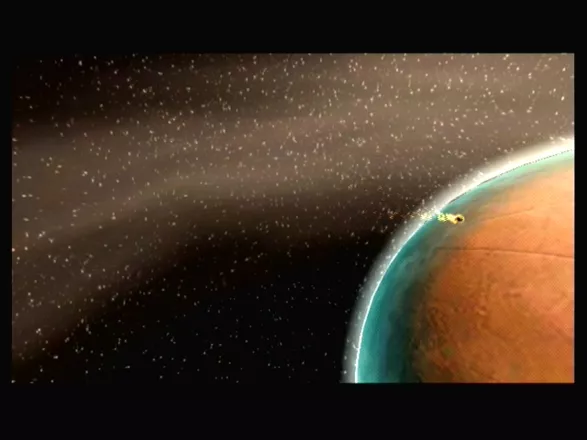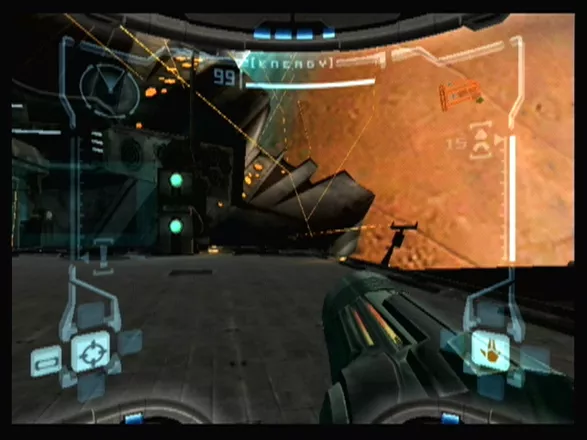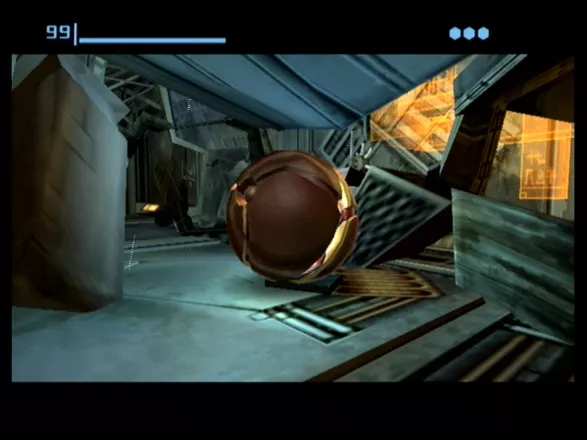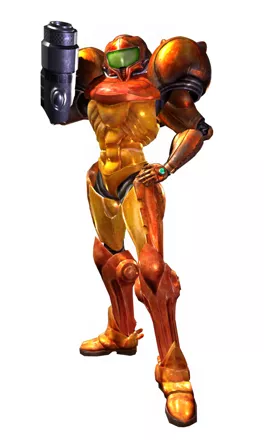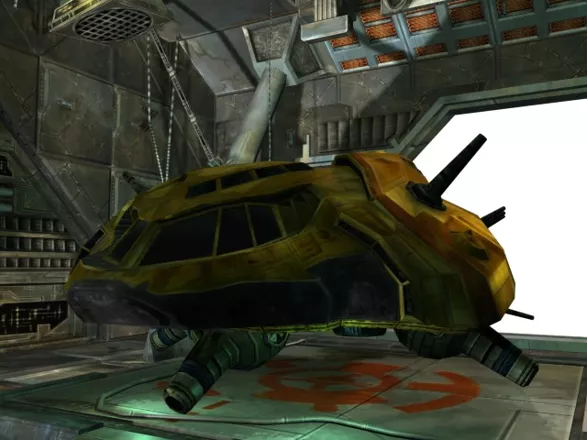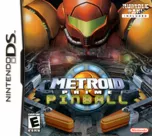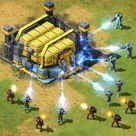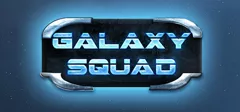Metroid Prime
Description official descriptions
Long ago, a bird-like race of creatures (called the Chozo) became extremely advanced technologically, but due to increasing violence in the universe, they began to hide and live more simple lives. The planet Tallon IV was the site of one of their colonies. Years later, a meteor crashed on Tallon IV releasing the strange element Phazon into the planet. Phazon poisoned anything it came in contact with, causing the plant and animal life to either die or mutate into a hideous form.
The Chozo tried to control the power of Phazon but failed. Before abandoning the planet, they were able to cover the impact crater with a temple and seal Phazon into the planet's core. Now space pirates have discovered Tallon IV, moving in to study Phazon and harnessing its power. They have also begun rebuilding their fortress on planet Zebes and reviving the Mother Brain, Ridley, and Kraid, all of whom were destroyed by Samus Aran. However, Samus has tracked the space pirates to Tallon IV and must now enter the planet to destroy them once and for all before they have a chance to rebuild their destructive forces...
Metroid Prime is a change from the platform-adventuring series, entering the first-person shooter genre for the first time. Players are now behind Samus Aran's visor and must use all their resources to investigate the pirate infestation of Tallon IV. Players can use Samus's beam, with missile and charge capabilities. Along the way, they must recover the bounty hunter's lost abilities like the morph ball and grapple beam, which allow them to reach unexplored areas of Tallon IV. Players must piece together the story of the fallen Chozo to figure out what has happened to the poisoned planet and prevent the pirates from using the Phazon to wreak havoc throughout the planets.
Spellings
- メトロイドプライム - Japanese spelling
- 银河战士 - Chinese spelling (simplified)
- 메트로이드 프라임 - Korean spelling
Groups +
Screenshots
Promos
Videos
Add Trailer or Gameplay Video +1 point
See any errors or missing info for this game?
You can submit a correction, contribute trivia, add to a game group, add a related site or alternate title.
Credits (GameCube version)
123 People (101 developers, 22 thanks) · View all
| Executive Producer | |
| Producer | |
| Lead Designer | |
| Senior Designers | |
| Designers | |
| Lead Engineer | |
| Technical Lead Engineers | |
| Senior Engineers | |
| Engineers | |
| Lead Artist | |
| Senior Artists | |
| [ full credits ] | |
Reviews
Critics
Average score: 96% (based on 94 ratings)
Players
Average score: 4.1 out of 5 (based on 228 ratings with 16 reviews)
The one that doesn't come out but once a generation...
The Good
Everything about this game is so good it makes you forget about anything you could think of wrong with it. The sound, graphics, game play, and controls are all excellently done.
The Bad
That I can't play it 24/7 without having to go to the bathroom or go eat or sleep...
The Bottom Line
This is the game you look for to come out once every consoles generation, and you know there won't be another one like it for that particular game platform unless they make a sequel for it. This game is so good that you can't put it down until then end, and when you do finally finish it, you find yourself going back through it to see if you can find anything you may have missed or any secrets that may be contained in it.
The game play is immersive and entertaining, and the way the story is presented to you is wonderfully done in a "search for the clues" type manner so that you never get bored doing only one thing all the time.
The graphics are seamless, the sound is perfect, the controls are right one que. Everything about this game begs for it to be a part of you gamecube library, so don't miss it and get it as soon as you can!!!
GameCube · by Angela Nichols (1) · 2003
When art rules, and gameplay suffers...
The Good
When a successful franchise is irrevocably altered to a new genre, it will be met with resistance, or at the very least, skepticism. Metroid Prime, the first American incarnation of a Japanese title by Retro Studios, achieves a highly polished game with some surprises, and tragedies. Many were alarmed when Metroid fans heard the infamous news... First Person Shooter. The transition from side scrolling action to 3D exploration is no small jump, and Retro Studios answers the call with slick graphics and the morphing ball... a narrow glimpse into what Retro really wanted.
The visual appeal of the game is incredible. There are many places in the game where a player can just stand in absolute awe of what the artists have achieved with this game and GameCube's power. Effects are top notch, nearly second to none. Backgrounds in places are genuinely creepy. Mood, lighting all of these elements make for an extremely satisfying visual experience.
The morphing ball experience speaks untold volumes about what this game could have been... This was undoubtedly the most exciting and liberating aspect of Metroid Prime. Allow me to step in here in person and say that, I think this was the game Retro was shooting for. The sense of movement and response was so compelling! I get the feeling they were going for 3rd person but they could never get the combat / lock on system to work well enough, so Miyamoto opted for the solution he knew Retro could do well... a FPS.
The Bad
Controls, the universal key to any game, in Metroid Prime is shot. It is Chaotic and non-intuitive and in terms of First Person Shooters it fails. Putting a camera lock and strafe mapped to a shoulder button is a mystifying concept. Why, when it is such an integral part of the game? Having you fingers fly all over the controller for scanning, aiming, locking, switching visors, switching weapons, strafing, jumping during combat is just ridiculous. It frustrates the player to such an extent of never playing again. Controls in Prime make no attempt to be logical or versatile.
If a characters abilities increase during the course of the game, "progression" becomes a relevant term. When the player gains new abilities Samus is enabled to do more, and it means just that. You have to do more, not less. In the standard rule of gaming, powerups are for the purpose of making your life easier, not difficult. Case in point, the visors. Switching visual spectrums is to view the world to find more is an incredible idea. Switching visors to fight a boss is tedious action and pulls the player right out of the gaming experience. In Super Metroid the X-Ray scope was only used for finding items or finding your way through the world... Why? because it stopped the game, literally. The same rule applies in Prime as well, it interrupts the flow of the game and is thoroughly annoying. Compare progression in a game such as Legend of Zelda, everything you gain makes your life easier and less tedious as you journey towards the end of the game. There are no powerups in Metroid Prime that enable you to do your job faster or with less tedious action. In fact, you could say the game becomes more tedious the longer you play. The challenge the game presents is not by what you are trying to defeat, but trying to overcome the controls! This is not logical game design.
The worlds are vast and visually diverse, but not gameplay diverse. The Magmoor caverns readily displays the fact it's hot and hazardous to be in there. In contrast Phendrana Drifts only visually show snow and ice... Well what are the characteristics of ice? Cold for one, slippery and brittle. All of those listed were potential gameplay aspects. Little or none of these aspects were incorporated into the design of the level to differentiate it from any other world.
The Bottom Line
Metroid Prime is pretty to look at. Had design been at the same level of the artists, I believe Prime would have been a truly extraordinary game. Metroid Prime frustrates the player on complexity of control, lack of progression and gameplay that is uninteresting by forcing the player to jump through gameplay hoops that don't work.
GameCube · by Vecster (19) · 2003
The Good
Retro have made a stylish job of updating this Nintendo classic to 3D. The map system - a scalable, rotatable wireframe model showing doors, save points etc. - is one of the best to grace any game on any platform, and is an invaluable tool for exploration of the massive but lonely world of Tallon. The gadgets and weapons are great, too - from Samus' ability to turn into a Sonic The Hedgehog-style 'Morph Ball' to the awesome visor system (enabling the player to see in x-ray or infra-red, for example). These features would, of course, be simple eye-candy without great design which Metroid Prime, fortunately, has in abundance. The designers have incorporated a huge number of mini-puzzles which must be solved in conjunction with the gear at Samus' disposal, and serve to make MP so much more than just another run-of-the mill FPS or platformer. For the completists out there, Samus' scanner can be used to check the facts and figures on every enemy and countless environmental features, at once providing further gameworld immersion and hints on solving puzzles or killing bosses. The amount of detail is staggering, as are the the graphics and sound (it is really worth playing with a Pro-Logic II system).
The Bad
The controls, whilst becoming second nature after several hours of play, are not particularly intuitive and may cause frustration in those players without a strong handle on the GameCube's controller. Be warned: Metroid Prime is quite difficult in places, although it is certainly worth persevering. Players expecting a classic FPS will also be out of luck - this game rewards those who seek to take in every inch of Tallon at their leisure, drinking in the lore of the planet's lost civilisation whilst obliterating its fantastic array of inhabitants. It's a shame, though, that Retro chose to stick with the cliched Fire Level Ice Level Forest Level design pattern, however well each has been executed.
The Bottom Line
Progress hinges on exploration and the aquisition of new gadgets and abilities (an early pair of 'double jump' boots, for example, enables Samus to reach otherwise inaccessible ledges) and it is this mechanic which players will either love or hate, as an amount of backtracking and seemingly aimless wandering is inevitable. Most gamers seem to love it, and it is definitely worth giving it a try.
GameCube · by Paul Jones (274) · 2004
Trivia
1001 Video Games
The GameCube version of Metroid Prime appears in the book 1001 Video Games You Must Play Before You Die by General Editor Tony Mott.
Development
Nintendo gave the development of Metroid Prime to the U.S. based Retro Studios in part due to the fact that the Metroid series, while being incredibly popular in the United States, has never sold as well in Japan.
Retro Studios also worked on a role-playing game for GameCube called Raven Blade of which a video was shown during E3 2001. However, in late 2001, it was announced that the game was canceled by Nintendo so that focus would be more on Metroid Prime. As a result, an unspecified amount of workers were laid off.
Manual
The manual has an amusing problem. Like in many of the Nintendo manuals, there is a lined page for the player's own notes, but the page has light lines on a very dark background. This makes most pen marks practically invisible, so the page is almost useless for its intended purpose (this applies to the Finnish/Swedish original release manual, at least).
Metroid Fusion
After finishing Metroid Fusion on the GBA, and linking up to a GameCube: * A new suit will be available * It will be possible to play the original Metroid on the GameCube
References
Kraid, from Metroid, was originally intended to make an appearance in Metroid Prime as a boss and was modeled and skinned by Gene Kohler for that purpose. However, time constraints prevented it from being included in the final version of the game. Though the beta version displays him inside Phazon Mines, according to Kohler, he was in fact replaced by the Omega Pirate. Kraid is referenced, however, in Metroid Prime. One of the tanks in the Space Pirate's base suggests that one of the Pirate's experiments is to recreate the creature. Body parts in the vat appear to be Kraid's. Of note is the head, since it appears to be covered by a metal dome in the picture.
Screw Attack
While many of Samus' signature moves are present in Metroid Prime, the infamous screw attack is strangely missing. Fans speculate that this is due to difficulties meshing it with the first-person perspective of the game. The screw attack does appear in Metroid Prime 2: Echoes.
Awards
- 4Players
- 2003 – Best Console Action Game of the Year (GameCube)
- Electronic Gaming Monthly
- February 2006 (Issue #200) - #52 in the "Greatest Games of Their Time" list
- GameSpy
- 2002 – Game of the Year
- 2002 – GameCube Game of the Year
- 2002 – GameCube Game of the Year (Readers' Choice)
- 2002 – Best Music of the Year (GameCube)
- Golden Joystick Awards
- 2003 - Runner up as GameCube Game of the Year (after The Legend of Zelda: The Wind Waker)
Information also contributed by ~~, Mark Ennis, Steve Thompson, Tiago Jacques, and WWWWolf .
Analytics
Upgrade to MobyPro to view research rankings!
Related Sites +
-
Metroid Prime
Nintendo's Official Site. -
Metroid Wiki
A Wiki site for the Metroid series.
Identifiers +
Contribute
Are you familiar with this game? Help document and preserve this entry in video game history! If your contribution is approved, you will earn points and be credited as a contributor.
Contributors to this Entry
Game added by Servo.
Wii added by gamewarrior.
Additional contributors: Unicorn Lynx, Guy Chapman, gamewarrior, Big John WV, Cantillon, Patrick Bregger, piltdown_man, Rik Hideto, FatherJack.
Game added November 20, 2002. Last modified January 22, 2024.




